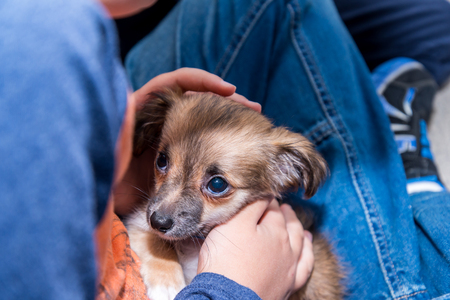1. Understanding Airline Pet Policies
Before booking your flight, its crucial to understand the pet policies of different airlines. Each airline has its own rules regarding pet travel, including whether pets can fly in the cabin or must be transported in cargo, specific breed restrictions, and carrier requirements. Knowing these policies ahead of time can help ensure a smooth journey for both you and your pet.
Cabin vs. Cargo Travel
Most airlines allow small pets to travel in the cabin, provided they fit inside an airline-approved carrier that can be placed under the seat in front of you. Larger pets usually need to be transported in the cargo hold. Each option has its pros and cons:
| Travel Option | Pros | Cons |
|---|---|---|
| Cabin Travel | – Your pet stays with you – Less stressful for your pet – Temperature-controlled environment |
– Only small pets allowed – Limited availability per flight – Can be expensive |
| Cargo Travel | – Suitable for larger pets – More space for movement – Available on most flights |
– Can be stressful for pets – Exposure to temperature changes – Requires additional preparation |
Breed Restrictions
Certain breeds, particularly brachycephalic (short-nosed) dogs like Bulldogs, Pugs, and Persian cats, may not be allowed to travel in cargo due to respiratory concerns. Some airlines also have restrictions on aggressive breeds for safety reasons. Always check with your airline before booking.
Carrier Requirements
Your pet’s carrier must meet airline specifications to ensure a safe and comfortable trip. Generally, carriers should be well-ventilated, secure, and large enough for your pet to stand up and turn around comfortably. Below are some common airline requirements:
- Soft-sided carriers: Preferred for in-cabin travel as they can fit under seats more easily.
- Hard-sided carriers: Often required for cargo transport as they provide better protection.
- Size restrictions: Each airline has its own size limits for in-cabin carriers—always check before flying.
- Adequate ventilation: Ensure at least two sides of the carrier have mesh panels for airflow.
- Securable closures: Zippers or locks must prevent accidental openings during travel.
2. Preparing Your Pet for Air Travel
Flying with your pet requires careful preparation to ensure a smooth and stress-free experience. From crate training to vet visits, here are the essential steps to get your furry friend ready for air travel.
Crate Training Your Pet
Your pet’s travel crate is their safe space during the flight, so it’s important they feel comfortable inside it. Start crate training weeks in advance by following these steps:
| Step | Description |
|---|---|
| Choose the Right Crate | Select an airline-approved crate that allows your pet to stand, turn around, and lie down comfortably. |
| Create a Positive Association | Encourage your pet to explore the crate by placing treats, toys, or bedding inside. |
| Gradual Introduction | Start with short periods of time inside the crate and gradually increase the duration. |
| Mimic Travel Conditions | Take your pet on car rides while inside the crate to simulate movement and get them accustomed to traveling. |
Schedule a Vet Check-Up
A visit to the vet is crucial before air travel. Ensure your pet is healthy and up-to-date on vaccinations. Some airlines require a health certificate issued within 10 days of travel, so check your airlines specific requirements.
Gather Necessary Documentation
The required paperwork may vary depending on your destination and airline policies. Common documents include:
- Health Certificate: Issued by a veterinarian, confirming your pet is fit to fly.
- Vaccination Records: Proof of required shots, such as rabies vaccination.
- ID Tags and Microchip Information: Ensure your pet’s identification is up to date in case they get lost.
- Airline-Specific Forms: Some airlines require additional paperwork, so check ahead of time.
Packing Essentials for Your Pet
Packing wisely can make a big difference in keeping your pet comfortable. Here are some must-have items:
- Comfort Items: A favorite blanket or toy can help ease anxiety.
- Food and Water: Pack enough for before and after the flight.
- Pee Pads or Litter: Useful for long journeys or layovers.
- Treats: Can be used as positive reinforcement during travel.
A well-prepared pet makes for a smoother trip! Taking these steps will help ensure your furry friend has a safe and comfortable flight experience.

3. What to Pack for Your Pet’s Flight
Packing the right items for your pet’s journey can make all the difference in ensuring a smooth and stress-free flight. From food and water to comfort items and emergency essentials, here’s a checklist of must-have items to bring along.
Essential Items for Your Pet’s Flight
To keep your pet safe and comfortable during air travel, make sure you have these key items packed:
| Category | Items |
|---|---|
| Food & Water | Collapsible water bowl, small bag of your pet’s regular food, bottled water, treats |
| Comfort & Security | Your pet’s favorite blanket or toy, calming spray (if needed), familiar-smelling item from home |
| Emergency Essentials | ID tags with updated contact info, copies of health certificates & vaccination records, any necessary medications |
| Travel Gear | A TSA-approved pet carrier with proper ventilation, pee pads or absorbent liners, waste bags |
| Safety Items | A secure harness and leash, microchip details (if applicable), recent photo of your pet (in case they get lost) |
Packing Tips for a Stress-Free Flight
Keep Food & Water Accessible
If the flight is long, ensure your pet has access to water before boarding. Some airlines allow small portions of food during travel, but check their policies beforehand.
Create a Comfortable Space
Your pet’s carrier should feel like a safe space. Line it with their favorite blanket or a soft towel to help them relax.
Prepare for Emergencies
Certain situations may require quick action. Having your pets medical records and emergency contacts handy can make all the difference in case of an unexpected issue.
Packing thoughtfully ensures that both you and your furry friend have a smooth flying experience. In the next section, we’ll cover what to do once you arrive at your destination!
4. Navigating Airport Security with Your Pet
Getting through TSA with your furry friend can feel overwhelming, but with the right preparation, you can make the process smooth and stress-free. Here’s what you need to know about handling security screenings and keeping your pet calm.
Tips for a Smooth TSA Screening
- Arrive Early: Give yourself extra time to go through security without feeling rushed.
- Use a TSA-Approved Carrier: Make sure your pet’s carrier meets airline and TSA requirements.
- Keep Documents Handy: Some airlines or destinations require health certificates, so have them ready.
What to Expect During Security Screening
Your pet will need to come out of their carrier while the carrier itself goes through the X-ray machine. You’ll carry or walk your pet through the metal detector.
| Step | What Happens |
|---|---|
| Remove Pet from Carrier | Your pet must be taken out of their carrier before going through security. |
| Send Carrier Through X-Ray | The empty carrier goes through the scanner like any other carry-on item. |
| Walk Through Metal Detector | You’ll carry or lead your pet through; if needed, TSA may swab your hands for explosives. |
| Reunite with Your Pet | Once cleared, put your pet back in their carrier securely before moving on. |
Keeping Your Pet Calm During Screening
- Practice at Home: Get your pet used to being taken in and out of their carrier in a calm setting.
- Use a Leash or Harness: This helps prevent your pet from getting loose during screening.
- Stay Calm: Pets pick up on your emotions, so staying relaxed can help them stay calm too.
- Treats and Comfort Items: Have a favorite toy or small treat handy for reassurance after screening.
With the right preparation, navigating airport security with your pet can be a hassle-free experience. Plan ahead, stay patient, and keep your pet comfortable throughout the process!
5. Tips for a Smooth Flight Experience
Flying with your pet can be stressful, but with the right preparation, you can make the journey more comfortable for both of you. Here are some best practices to ensure a smooth experience during takeoff, in-flight, and landing.
Helping Your Pet Stay Calm During Takeoff
Takeoff can be one of the most stressful moments for pets due to sudden noise and pressure changes. Here’s how you can help:
- Use a familiar carrier: Ensure your pets travel carrier is familiar by letting them spend time in it before the flight.
- Keep calm yourself: Pets pick up on their owners emotions, so staying relaxed will help reassure them.
- Offer a comfort item: Place their favorite blanket or toy inside the carrier for familiarity and security.
- Consult your vet: If your pet has anxiety, talk to your vet about natural calming solutions or medications.
Keeping Your Pet Comfortable In-Flight
Once in the air, maintaining your pet’s comfort is key. Follow these tips:
- Monitor temperature: Ensure your pet isnt too hot or too cold by adjusting airflow around their carrier.
- Avoid excessive food or water: Feeding right before flying can lead to discomfort; offer small amounts of water instead.
- Use calming aids if needed: Pheromone sprays or anxiety wraps may help some pets feel more secure.
- Check on them discreetly: Speak softly or place a hand near the carrier to reassure them without opening it.
Managing Bathroom Breaks and Landing
Pets might need relief before landing, especially on longer flights. Plan accordingly:
| Flight Duration | Bathroom Break Strategy |
|---|---|
| < 3 hours | Avoid food/water 2 hours before the flight; provide a potty break right before boarding. |
| 3-6 hours | Use an absorbent pad in the carrier and offer limited water during the flight. |
| > 6 hours | Consider booking layovers to allow bathroom breaks at designated pet relief areas in airports. |
As you prepare for landing, speak reassuringly to your pet and get ready to give them a break as soon as possible after deplaning.
Final Pre-Landing Checklist
- Reassure your pet: Use a calm voice and check that they are comfortable.
- Avoid sudden movements: Keep their carrier stable while the plane descends.
- Prepare for deplaning: Have a plan for where you’ll go immediately after exiting the aircraft for relief and comfort.
A well-prepared flight makes all the difference in keeping your pet safe and happy. By following these tips, youll help ensure a smoother experience for both you and your furry companion.


